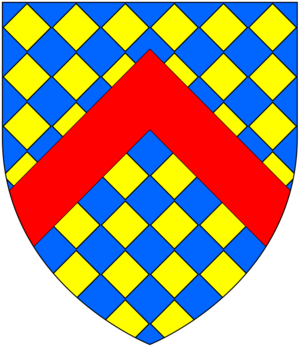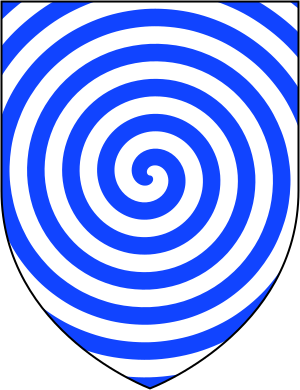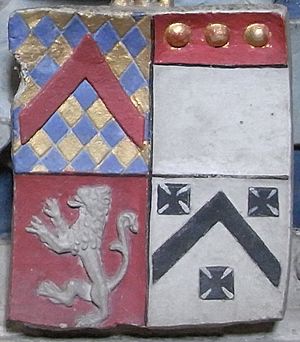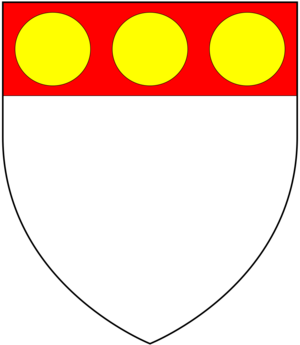Ferdinando Gorges facts for kids
Quick facts for kids
Ferdinando Gorges
|
|
|---|---|

Arms of Gorges (modern): Lozengy or and azure, a chevron gules. These arms resulted from the famous 1347 heraldry case of Warbelton v Gorges
|
|
| 2nd colonial governor of Maine | |
| In office 1639 – 24 May 1647 |
|
| Preceded by | William Gorges |
| Succeeded by | Thomas Gorges |
| Personal details | |
| Born | c. 1565-1568 Clerkenwell, Middlesex, England |
| Died | 24 May 1647 (aged 78–82) Ashton Phillips, Somerset, England |
| Spouses | Ann Bell (died 1620); 4 children. Mary Fulford {Mrs Achims (a widow)} Elizabeth Gorges, {Mrs Courteney (a widow)} Elizabeth Gorges {Lady Smyth (a widow)} |
| Profession | Governor, entrepreneur and founder of the Province of Maine |
| Signature |  |
Sir Ferdinando Gorges (born around 1565-1568, died May 24, 1647) was an important English naval and military leader. He was the governor of Plymouth, a major port in England. He played a big part in early English efforts to trade with and settle North America. He is often called the "Father of English Colonization in North America" because of his work in founding the Province of Maine in 1622. Interestingly, Gorges himself never actually visited the New World.
Contents
Early Life and Family History
Ferdinando Gorges was born between 1565 and 1568. He was likely born in Clerkenwell, Middlesex, where his family had a town house in London. He might also have been born at his family's country estate, called a manor, in Wraxall, Somerset. He was the second son of Edward Gorges and Cicely Lygon.
His Family Roots
Ferdinando Gorges came from the Russell family. An early ancestor was Sir John Russell (died around 1224). He was a knight for King John and King Henry III.
The Gorges family arrived in England with the Norman Conquest. The original Gorges family line ended in 1331. However, a member of the Russell family, Theobald Russell, inherited their lands. He agreed to take on the Gorges name and family symbol. Ferdinando was a descendant of this Theobald Russell "Gorges."


The Gorges family had lived in Somersetshire since the time of King Henry I. They held their estates in Wraxall since King Edward II's time. They often received important jobs and special rights from the King.
Ferdinando's mother was Cecily Lygon. Her family could trace their history back to King Richard II. Ferdinando was named after his mother's brother, Ferdinando Lygon.
Military Career
We don't know much about Gorges's early life or schooling. He likely started his military career in his mid-teens, which was common then. He was probably involved in the Anglo-Spanish War which began in 1585.
In 1587, Gorges was a captain. He commanded soldiers sent to help the Earl of Leicester during the Siege of Sluis in the Netherlands. He fought under Lord Willoughby and became close with his family.
Gorges was wounded during the siege of Paris in 1589. He was made a knight at the siege of Rouen in 1591. For his service, he was given the important job of Governor of the Fort at Plymouth, which he held for many years.
In 1597, during the Spanish Armada, Gorges helped warn England. This allowed the country to prepare its defenses. However, autumn storms scattered the Spanish fleet.
In 1601, he was involved in the Essex Conspiracy. He later provided information about its leader, Robert Devereux.
Efforts to Colonize North America
Gorges became interested in colonization when Captain George Weymouth brought him three captured Native Americans. Gorges believed one of them was Tisquantum, also known as "Squanto."
In 1607, Gorges was a shareholder in the Plymouth Company. He helped fund the Popham Colony in what is now Phippsburg, Maine. This colony, however, was not successful.
In 1622, Gorges and John Mason received a special document called a land patent from the King's Plymouth Council for New England. This patent gave them land for the Province of Maine. The original area was between the Merrimack and Kennebec rivers. This is how "Ye Province of Maine" began.
In 1639, King Charles I gave Sir Ferdinando Gorges even more power over this new province. The King stated that it "shall forever hereafter, be called and named the PROVINCE OR COUNTIE OF MAINE."
In 1629, Gorges and Mason divided the colony. Mason's part became the Province of New Hampshire. Gorges and his nephew set up Maine's first court system. Captain Christopher Levett, an early English explorer, worked for Gorges. Levett tried to start a colony in Maine, but it failed.
Gorges's son, Robert Gorges, was Governor-General of New England from 1623 to 1624. However, American colonists were unsure about Robert Gorges's ideas for how the colony should be run. He eventually returned to England. In the 1630s, Ferdinando Gorges tried to restart the Plymouth Company's claims. He worked with colonists who had been banned from the Massachusetts Bay Colony. He questioned the Massachusetts Bay Colony's royal charter and sent complaints to King Charles I's Privy Council. His efforts were not successful.
Marriages and Children
Sir Ferdinando Gorges was married four times:
- His first marriage was in 1589 to Ann Bell (died 1620). They had two sons and two daughters:
- John Gorges
- Robert Gorges
- Ellen Gorges
- Honoria Gorges (who died young)
- His second marriage was in 1621 to Mary Fulford.
- His third marriage was in 1627 to Elizabeth Gorges (died 1629).
- His fourth marriage was in 1629 to Elizabeth Gorges, Lady Smyth.
Death and Legacy
Sir Ferdinando Gorges died on May 24, 1647. He was buried in the Smyth family crypt at All Saint's Church in Long Ashton. His oldest son, John, inherited his rights to the Province of Maine.
In May 1677, Ferdinando's grandson, also named Ferdinando Gorges, sold all his family's rights to Maine to the state of Massachusetts for £1,250. This sale ended the Gorges family's connection to the American lands that Sir Ferdinando had worked so hard to develop. New England then followed a very different path. Maine did not become a separate state until 1820.
See also
| Wikisource has the text of an 1879 American Cyclopædia article about Ferdinando Gorges. |
Images for kids



